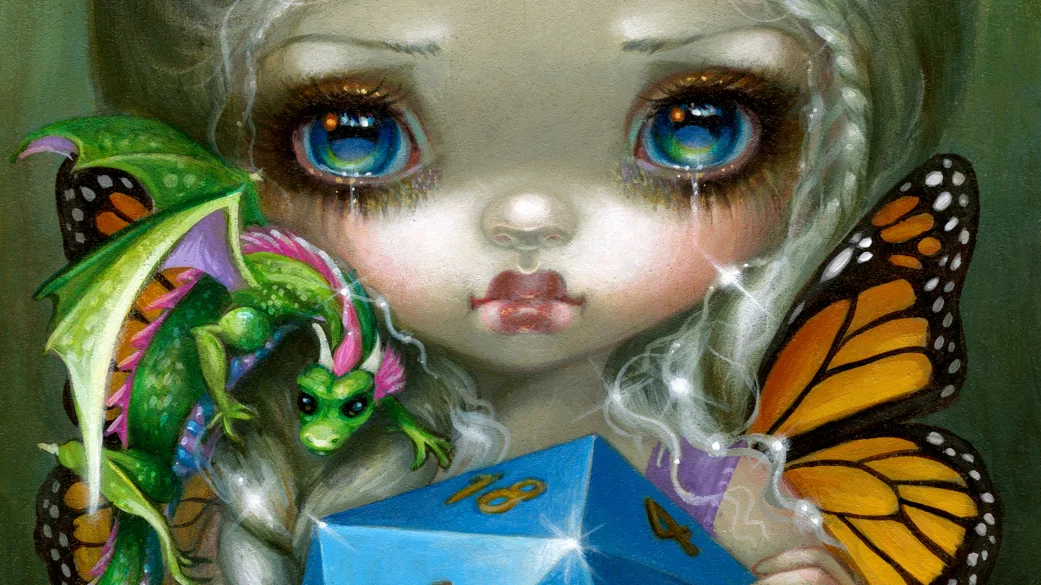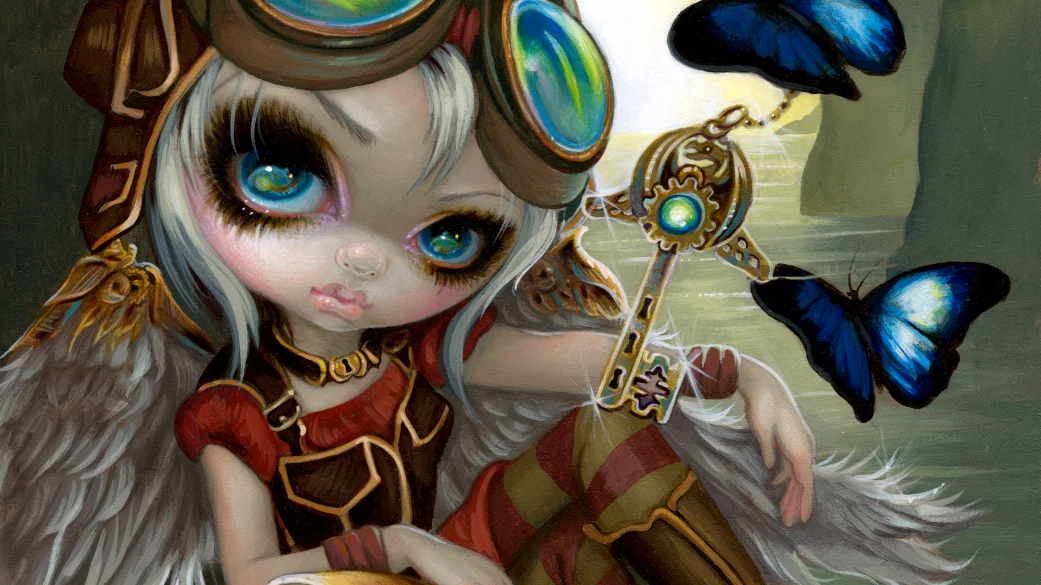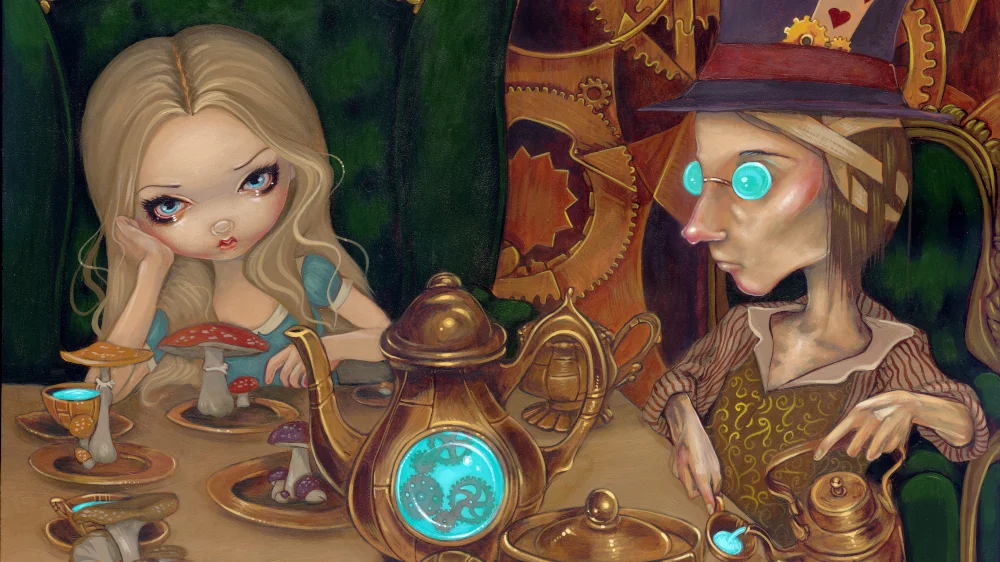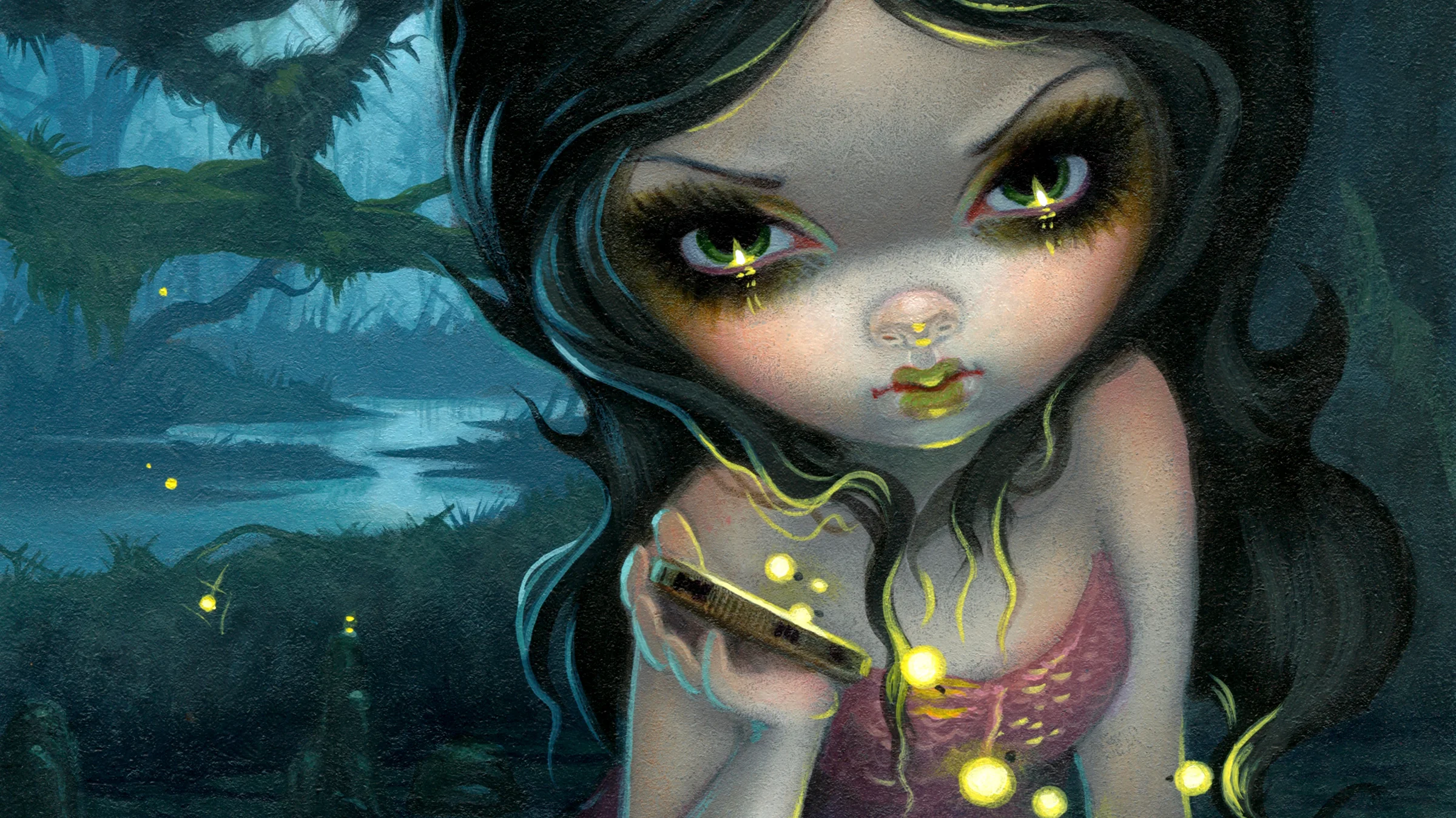If you're a fan of fantasy art, or if you've been to the shops in Disney World, or maybe you used to hang around Hot Topic as a teen, then you probably know the work of artist Jasmine Becket-Griffith. Her paintings of mythical characters are in a style that has defined a subgenre in modern fantasy fandom and, for me, recalls the art of Wendy Pini's Elfquest combined with the somber mood of Edward Gorey. Jasmine's paintings proved long ago that scary could be cute, and that "cute" could be stunningly magical. And now she's proving that genre-defining art can be open.
Recently, Jasmine Becket-Griffith has placed hundreds (625 to be exact) of high-resolution scans of her paintings in the public domain (or Creative Commons, as needed) so that they're free for everyone to use, re-use, and repurpose. As a longtime fan of fantasy art in general and an admirer of her work, I wouldn't have believed it myself if the announcement hadn't come from her official website, Strangeling.com. I contacted her for more information and found that she was no stranger to open source or the idealism of free culture.
Q: Your illustrations are instantly recognizable and very popular. Why did you choose to make them free for the public to download and use?
Jasmine Becket-Griffith: I had many reasons for gifting my artworks to the public, the primary being exactly that—the public wants them. The public has always had such a positive response and immediate connection to my work, and at some point over the years I believe a "tipping point" was reached where the demand was impossible to meet through traditional channels.
I feel the only (and inevitable) way I can keep up and supply my content to meet the public demand is to remove all barriers between myself as the artist and the public as the consumer. By forfeiting the traditional protections of intellectual property/copyright law and using Creative Commons Open Commercial License (CC0), I've removed the threat of third-party governance of my images, even by me. By offering the works for free or a suggested donation, I have leveled the playing field for fans or entrepreneurs alike to all have open access to the content.
By not involving middlemen, such as licensors and agents, I've granted freedom to any individual or company to be creative or profit without bureaucracy, fees, or predatory egos.
By forfeiting my IP rights on the images, I've also finally relinquished myself of the impossible copyright quagmire of being a modest individual person expected to somehow have the legal resources of a massive brand to litigate against piracy. There aren't enough hours in the day to even file the DMCA takedown notices the way the current system is set up. The only option I had, in this particular instance, to cease becoming a victim was to decriminalize the crime by forfeiting my ownership rights.
By building a simple click-and-download retrieval system, I've created an easy interface for all people, all ages, worldwide, to immediately have access to the high-resolution scans of 625 for my original acrylic paintings for any use.
Fans in Australia can print their own posters at home instead of requiring unnecessary international shipping and the resources involved. Wal-Mart's graphic design department can make t-shirts featuring immediately recognizable, branded, and delightful characters made from my careful high-resolution scans. They can choose to send me a few dollars if they want to. Students and educators can now, free of charge and restriction, download the files to zoom in and see brushstrokes (and cat hairs and fingerprints) in high resolution to help learn about some of the innovative ways I have painted with acrylic paints over the decades.
Crafters and entrepreneurs are encouraged to use the Strangeling images and characters as content to repurpose in their own product lines at art fairs, farmer's markets, or Etsy shops.
Aspiring comic artists, video game designers, TikTok-ers, existing animation giants—all are welcome to utilize the Strangeling Public Domain Project as a shared resource for any purpose that inspires them creatively or commercially and with my explicit blessing.
To help me continue to spend my time creating new content and painting new paintings, it's my conviction that enough of the public will see the value in what I am doing and that many will choose to support the Strangeling Public Domain project by donating to the Tip Jar or pledging $1 or more for staggering additional content up at my Patreon.

Q: From the sheer number of drawings released, you're obviously a prolific artist. What inspires and drives you?
JBG: Oh, that is the question. I'm a compulsive painter; it dominates my time to the exclusion of most else. There's something in me that feels that it is important that I continually try to translate visually the things and ideas from this world that I find mysterious and magical.
It takes many forms, and inspiration comes from everywhere. By removing a lot of the commercial pressures involved with creating, I am now inspired to paint more pieces both for myself and for the public.
Q: "Compulsive painter" must be an understatement. You've released over six-hundred works!
JBG: In the initial stages of project development, I basically picked a good sampling of previously released images that would fit on a thumb drive.
All of the 625 pieces in the initial launch of the Strangeling Public Domain Project are my original acrylic paintings, painted in acrylic paints and water on either canvas or wood panel. It actually represents only a portion of the paintings I have done since I started Strangeling in 1997.

Q: Do you primarily paint digitally, with media, or a mix of both?
JBG: I never paint digitally—I see digital painting as being a completely different sort of physical activity than painting with paint and wood. It is mostly the activity of creating the painting that interests me as an artist. The way my mind works, I see it just as different as playing a scuba-diving video game on your couch as opposed to being underwater in the ocean and having wet hair. If you spent a day doing one as opposed to the other, your day would look completely different. The paintings I do are with acrylic paints (mostly I use Golden brand fluid acrylics), a little tap water, a piece of wood or MDF panel, or canvas. I paint with my fingers and with cheap vegan-friendly brushes.
Q: Do you use any open source software in your art?
JBG: Not to actually paint, but I rely a tremendous amount on open source content for research materials, museum databases for historic painting references, and other channels that have a similar concept driving them.
In a way, I see the Strangeling Public Domain Project as an attempt at democratizing fine art and commercial image licensing as a sort of "Open Source Art Project."
Q: How important is shared culture for artists?
JBG: Very. Artists are basically translators or conduits; it's our responsibility to take our observations and repackage them into something consumable by the public. This way, the message is translated.
As painters, musicians, or other content providers, we must use our skills to decorate these messages aesthetically or viscerally, to create a shared emotional bond. This is how we share and create new culture.
Q: How important is art for society?
JBG: Maybe the most. After all, what else are we struggling for? I don't know if there is a better definition of what society and culture actually are if it's not the traditional call and response of content creator and content consumer—between artist and viewer, between musician and listener. Society needs artists as decoders to translate and write our culture, just as we need our computer coders to construct the framework upon which we build our digital society.

Q: Why did you decide to become a professional artist?
JBG: I think in the end, I had no choice. It was the natural evolution. I began selling my artwork door-to-door at age five and started Strangeling when I was seventeen. I was going to spend all of my time painting anyway—I might as well make a living out of it and try to do something that engages the rest of the world while I'm at it.
Q: Now that the Strangeling Public Domain Project has officially launched, what's next?
JBG: One of the delightful things about the project is that it has opened me up to spend time on projects that require a lot of my personal attention and let me explore new territory.
I'll be doing more new paintings with the Walt Disney Company, LucasFilm, and Pixar—copyrighted, of course by Disney, but painted by me for their WonderGround Galleries, Disneyland, and Disney World theme park locations. Disney has the unique position of having me create licensed works featuring the official Disney characters with their copyright, but painted by me—Jasmine Becket-Griffith—a very commercial but undeniably American cultural keystone.
I've been collaborating with painter David Van Gough for our co-branded Death & the Maiden™ collection. Being involved with jointly owning a brand new intellectual property has been cathartic in a way that could only have been predicated by having my back catalog of previous work being made Public Domain.







Comments are closed.